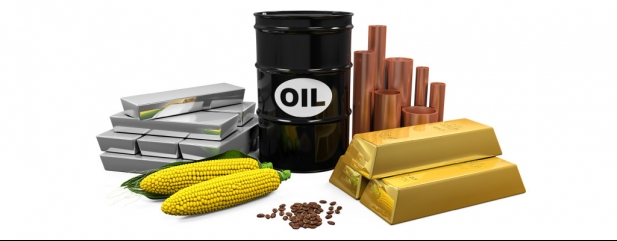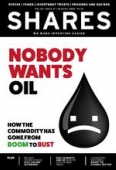Archived article
Please note that tax, investment, pension and ISA rules can change and the information and any views contained in this article may now be inaccurate.
Most commodities and all cryptocurrencies do not suit new investors

When you see adverts talking about how you can make a mint quickly by ‘trading the markets’, if they are not referring to foreign exchange then they are typically focused on commodities and cryptocurrencies.
While a majority of us might know what cryptocurrencies are (or at least think we do – more on that later), commodities are an oft-mentioned term in finance and business articles which people don’t really stop to explain.
Commodities are raw materials which can be bought or sold. Examples of commodities include metals like copper or gold, agricultural products like coffee or cocoa beans, and energy sources like oil and gas.
It should be made clear that commodities and/or cryptocurrencies are not a natural starting point for first-time investors. It is important to know what they are – yet they should only be considered by more experienced investors who understand how they work and already have experience investing in other assets like shares and bonds.
This is an important point. A lot of people might see adverts on YouTube, for example, saying to start playing the markets via trading Bitcoin. Individuals might come to the conclusion that’s a natural starting place to try and get a better return than cash. We disagree.
These are very high risk places to invest or trade, depending on your viewpoint, and it is easy to lose money very quickly.
THE PROS AND CONS OF COMMODITIES
There is often a lot of excitement around commodities and it is easy to see why people might be attracted. Shares in commodity explorers and producers can deliver spectacular returns, although they can also be disastrous investments.
Many companies who think they’ve found a big amount of oil in the ground or metal in a mountain eventually find out there isn’t enough stuff that’s economical to extract.
It’s also important to understand that commodity producers have no pricing power which means they can’t set the price at which they will sell material.
The price of the vast majority of commodities is set by the interaction between supply and demand. High demand and low supply sees prices go up, while high supply and low demand sees prices go down.
But that’s not to say it’s not worth investing in commodities, as there is a time and place for looking at them.
THE APPEAL OF GOLD
Gold is considered the ultimate safe-haven asset, which is something that is considered good at protecting you when markets are weaker, however this is not guaranteed.
How to invest in gold
When people talk about the gold price and how it’s rising or falling, it may be more relevant than you think.
Just like those coins from the Royal Mint or the big slabs held deep in the vaults of the world’s biggest central banks, gold is valued by the prevailing market price.
Usually this value is quoted in US dollars and by ounce. For the last 10 years, gold has been valued at anywhere between $1,000 and $1,900 per ounce.
Gold jewellery or buying a gold coin are ways to invest in gold, but in these cases you also have to think about the cost of insurance.
Perhaps an easier way to get exposure, particularly if you can’t afford to splash out over a grand for an ounce of gold, is to invest in a fund which tracks the gold price.
An example includes exchange-traded fund iShares Physical Gold (SGLN) whose value moves up and down in line with the gold price. You don’t actually receive gold; you’re buying shares in the fund which tracks the metal price. You can also get exchange-traded funds which track most other commodity prices.
Other ways to get exposure to gold include buying shares in gold mining companies. You have to consider this comes with added risks such as a company’s financial strength, geopolitical risk where governments impose heavy taxes on mining in order to get their share of the riches, and operational risks.
Shares in mining companies can outperform an increase in the commodity they are producing because of these extra risks but they can also fall harder than a decline in the commodity price. This applies to gold and any other type of commodity.
Other examples of safe-haven assets include government bonds from wealthy countries (because they’re not likely to turn round to investors and say we can’t pay you back), the US dollar (it’s the most traded currency in the world) and cash, which isn’t going anywhere if it’s sitting in your account and not subject the whims of the stock market although inflation will eat away at your returns.
Gold tends to have a negative correlation with equities – essentially when the stock market falls, gold usually goes up, though this is not guaranteed.
Then there are other commodities like copper, the price of which could potentially increase for a prolonged period of time because it’s a really important metal in making electric vehicles among other things.
If there is this ‘electric vehicle revolution’ we’ve all been promised will happen, car manufacturers will require way more copper than they need at the moment.
ALL ABOUT CRYPTOCURRENCIES
Cryptocurrencies are a much newer asset class, i.e. group of investments. A cryptocurrency is a digital or virtual currency designed to work like other types of money, except it has no coins or notes and exists only in electronic form. They usually allow for secure payments to be made online.
Popular cryptocurrencies
Bitcoin is the most popular cryptocurrency globally, but there are two others which also hold significance – Ethereum (Ether) and Ripple.
Ethereum is actually the name of the blockchain, or infrastructure, which supports the Ether currency – the second most traded cryptocurrency globally – but most people call the currency itself Ethereum.
It is a popular cryptocurrency for companies who engage in initial coin offerings (ICOs), which are similar to crowdfundings or initial public offerings (IPOs) but use crypto money instead of physical money.
While Ripple is often regarded as the ‘establishment’ currency because it was set up to support the transfer of fiat currencies, i.e. money declared by a government as legal tender.
A number of banks use the currency, and Plus500 reckons there’s a ‘genuine possibility’ it could become part of the traditional finance system one day.
Unlike pounds or dollars, they’re not issued by any central authority like a government or a central bank, and so are theoretically immune from any government interference.
But cryptocurrencies are still a nascent area, given the first decentralised one to be created was Bitcoin in 2009. They can suffer from extreme exchange rate volatility, while there can also be problems with the underlying infrastructure.
According to trading platform Plus500, there are more than 1,600 cryptocurrencies listed on major, medium-sized and specialist cryptocurrency exchanges.
The most well-known cryptocurrency is the aforementioned Bitcoin, which is the most traded in the world and the price of which influences the rest of the crypto market.
Unlike normal currencies which can be printed, there are only a fixed number of Bitcoins in existence. This is meant to prevent inflation which can be caused by money printing.
NOT FOR FIRST-TIME INVESTORS
A growing number of people have made a lot of money from trading cryptocurrencies and taking advantage of the price growth and volatility.
However, many more have lost a fortune, and cryptocurrencies should only ever be considered by experienced investors who have a detailed knowledge of how they work, understand all of the risks and are only prepared to invest money they can afford to lose.
First-time investors are better off starting with funds that invest in stocks and bonds, and potentially adding commodities (principally gold) once you’ve built a core portfolio.
Important information:
These articles are provided by Shares magazine which is published by AJ Bell Media, a part of AJ Bell. Shares is not written by AJ Bell.
Shares is provided for your general information and use and is not a personal recommendation to invest. It is not intended to be relied upon by you in making or not making any investment decisions. The investments referred to in these articles will not be suitable for all investors. If in doubt please seek appropriate independent financial advice.
Investors acting on the information in these articles do so at their own risk and AJ Bell Media and its staff do not accept liability for losses suffered by investors as a result of their investment decisions.
Issue contents
Editor's View
First-time Investor
Great Ideas
- Digital change expert Kainos remains a great pick
- Time to take profits on IT security group Avast
- Computacenter resilient but dividends are off the menu
- Luceco can move beyond ‘darkest hour’
- Buy ITV shares as advertising activity could soon pick up
- Travis Perkins can capitalise on homebuilding restart

 magazine
magazine











